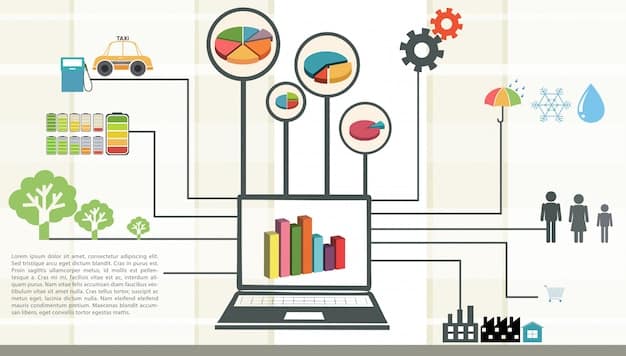Inflation’s impact on US tech spending: optimization strategies

The continuous rise in inflation profoundly
influences US tech spending by necessitating strategic cost optimization, driving companies to re-evaluate cloud usage, software subscriptions, and hardware lifecycles to maintain operational efficiency and competitive advantage.
The landscape of technology expenditure in the United States is currently undergoing a significant transformation. At the heart of this shift is the impact of inflation on US tech spending: strategies for cost optimization becoming not just beneficial, but essential for businesses striving to maintain their competitive edge and operational efficiency. As economic pressures mount, understanding how to navigate these challenges through intelligent spending is paramount for tech leaders.
The economic pressures on tech budgets
The US economy has experienced sustained inflationary pressures, impacting nearly every sector, and technology is no exception. Companies are finding that the cost of everything, from essential hardware and software licenses to the talent required to innovate, is steadily increasing. This rising tide of expenses can quickly erode profit margins and hamstring growth initiatives if not properly managed.
This economic reality forces a critical re-evaluation of how tech budgets are constructed and deployed. Leaders must shift from a mindset of unchecked expenditure to one of strategic investment, prioritizing solutions that deliver demonstrable value and measurable returns on investment. The days of limitless IT budgets fueled by abundant capital are, for the moment, behind us, replaced by a more disciplined approach.
Rising operational costs
One of the most immediate effects of inflation on tech spending is the direct increase in operational costs. This includes the energy required to power data centers, the fees associated with cloud services, and the rising cost of network infrastructure. Businesses that once enjoyed predictable recurring expenses are now confronting fluctuating figures, demanding real-time adjustments and adaptive procurement strategies.
Furthermore, the global supply chain, still recovering from recent disruptions, continues to contribute to elevated prices for physical tech components. Semiconductors, servers, and even basic peripherals have seen their costs surge, extending lead times and putting pressure on budget allocations. Companies must forecast these costs with greater precision and explore alternative sourcing options to mitigate impact.
- 📈 Increased energy bills for data centers.
- 📊 Higher fees for cloud computing services.
- ⚙️ Elevated prices for hardware components.
- 🧑💻 Rising salaries for tech talent.
Impact on software and licenses
Software subscriptions and licensing fees, often considered fixed costs, are also subject to inflationary forces. Vendors, facing their own increased operational costs, frequently pass these on to customers through price adjustments. For organizations relying on a multitude of software solutions, these incremental increases accumulate quickly, creating significant budgetary strain.
This necessitates a closer examination of software portfolios. Are all licenses being used effectively? Are there redundancies? Can open-source alternatives provide comparable functionality at a lower cost? These questions, once secondary, are now central to tech spending decisions. Moreover, negotiating longer-term contracts with favorable terms can help lock in pricing before future inflationary hikes.
In essence, the rising cost of doing business is pushing tech leaders to become more financially astute, transforming IT departments into cost centers that must actively contribute to the company’s financial health rather than merely consuming resources. This shift requires a blend of technical expertise and economic foresight.
Strategic software and cloud optimization
In an era where software and cloud services constitute a significant portion of tech spending, optimizing these areas becomes a primary strategy for cost control. This isn’t merely about cutting costs, but rather about maximizing value and ensuring every dollar spent delivers maximum impact. It’s an ongoing process that requires constant monitoring and adaptation.
Effective software and cloud optimization requires a deep understanding of current usage patterns, future needs, and available market solutions. It also means fostering a culture of financial accountability within technical teams, ensuring that resource consumption is always aligned with business objectives.
Rightsizing cloud infrastructure
Many organizations initially migrated to the cloud with exuberance, often over-provisioning resources “just in case.” Inflation, however, makes such inefficiencies unsustainable. Rightsizing cloud infrastructure involves meticulously assessing actual usage against allocated resources and adjusting accordingly. This could mean downgrading instance types, resizing databases, or leveraging serverless architectures.

Furthermore, cloud cost management platforms can offer invaluable insights, identifying idle resources, optimizing storage tiers, and recommending more cost-effective service configurations. The goal is to pay only for what’s genuinely needed and utilized, avoiding waste from unused capacity. Reserved instances and savings plans should also be explored for stable workloads.
Software license management
Software license management is another critical area for optimization. Many companies pay for dormant licenses, redundant subscriptions, or features they never use. A comprehensive audit of all software assets can reveal significant opportunities for savings. This includes enterprise applications, specialized tools, and even smaller, department-specific subscriptions.
Implementing robust software asset management (SAM) tools can automate this process, tracking usage, identifying underutilized licenses, and ensuring compliance. Beyond simple cost reduction, effective SAM can also minimize legal risks associated with non-compliance. Negotiating bulk discounts or exploring tiered pricing models with vendors can also yield substantial savings.
- 🔍 Conduct regular audits of all software licenses.
- ⚡ Identify and eliminate unused or redundant subscriptions.
- 🤝 Negotiate better terms with software vendors.
- Opensource solutions for cost savings.
The objective is to eliminate “shadow IT” and ensure that every software acquisition is intentional, necessary, and delivers tangible business value. This proactive approach to software and cloud spending transforms these areas from passive cost centers into actively managed, value-driven investments.
Embracing automation and AI for efficiency
In the face of rising costs, automation and artificial intelligence (AI) emerge as powerful tools for enhancing efficiency and, by extension, optimizing tech spending. By automating repetitive tasks, reducing human error, and providing predictive insights, these technologies can deliver significant operational savings and unlock new levels of productivity.
The investment in automation and AI should be viewed not as an additional expense, but as a strategic move to build a more resilient and cost-effective operational model. It’s about doing more with less, empowering existing teams, and freeing up valuable human capital for higher-value activities.
Automating routine IT tasks
Many IT operations consist of routine, repetitive tasks that consume significant time and resources. Examples include security patching, system monitoring, user provisioning, and incident response. Automating these activities through scripting, robotic process automation (RPA), or IT orchestration platforms can drastically reduce manual effort and the associated labor costs.
Beyond direct cost savings, automation also improves consistency, reduces errors, and speeds up service delivery. This efficiency gain contributes to overall cost optimization by minimizing downtime, enhancing security posture, and improving user satisfaction. The initial investment in automation tools and expertise often yields a rapid return.
AI-driven insights for cost prediction
Artificial intelligence, particularly machine learning, can analyze vast datasets to provide predictive insights into tech spending patterns. AI models can forecast future resource consumption, identify potential cost overruns, and recommend optimal resource allocation. This proactive approach allows organizations to make data-driven decisions that prevent costly surprises.
For instance, AI can optimize cloud spending by predicting traffic spikes and scaling resources up or down automatically, ensuring costs are aligned with demand. It can also identify anomalies in spending that might indicate inefficient practices or even security breaches. By leveraging AI, companies can move beyond reactive cost management to a more predictive and preventative model.
By strategically implementing automation and AI, organizations can not only mitigate the impact of inflation on tech spending but also establish a more agile, cost-efficient, and future-ready IT environment. These technologies are not just about cutting costs; they are about fostering smarter operations.
Vendor negotiations and strategic partnerships
In times of economic pressure, the relationship with technology vendors moves from transactional to strategic. Effective negotiation and the establishment of strong, mutually beneficial partnerships become crucial levers for cost optimization. It’s about leveraging collective buying power and finding win-win scenarios that support both parties’ objectives.
This approach requires more than just haggling over prices; it involves understanding vendor cost structures, anticipating market trends, and building long-term relationships based on trust and shared goals. Strategic sourcing can unlock significant savings and provide access to more favorable terms.
Leveraging bulk discounts and long-term contracts
One of the most straightforward negotiation tactics is to leverage buying power through bulk discounts and longer-term contracts. Consolidating vendors for similar services or committing to multi-year agreements can often unlock better pricing than month-to-month or a la carte purchases. This is particularly true for SaaS subscriptions and cloud services.
While long-term contracts require careful forecasting of needs, they can provide budget predictability and insulate against future price increases for the duration of the agreement. It’s important to build in flexibility clauses, however, to account for unforeseen changes in business requirements or market conditions.
- Negotiate multi-year contracts for stable services.
- Consolidate vendors to maximize purchasing power.
- Explore tiered pricing models based on usage.
- Include performance and exit clauses in agreements.
Exploring alternative vendors and open-source solutions
A healthy vendor landscape encourages competition and provides leverage during negotiations. Periodically exploring alternative vendors—even if the intention isn’t to switch—can provide valuable benchmarks for current pricing and service levels. This market intelligence strengthens a company’s negotiating position with incumbent providers.
Furthermore, open-source solutions present a compelling alternative for many tech needs. While open source often involves higher internal development or integration costs, it eliminates licensing fees and can offer significant long-term savings, particularly for core infrastructure components like operating systems, databases, and development tools. Evaluating the total cost of ownership (TCO) for both proprietary and open-source options is key.
Ultimately, strategic vendor management transforms procurement from a reactive process into a proactive function that actively contributes to cost optimization and ensures that every tech investment is aligned with the company’s financial objectives.
Optimizing hardware lifecycles and asset management
Hardware, despite the increasing shift to cloud-based solutions, remains a significant capital expense for many organizations. Managing its lifecycle effectively—from procurement to disposal—is crucial for containing costs, especially as inflationary pressures drive up component prices and logistics fees. It requires a disciplined approach to asset management.
The goal is to extend the useful life of assets where appropriate, make intelligent purchasing decisions, and optimize maintenance schedules. This extends beyond server rooms to employee devices, network equipment, and specialized machinery.
Extending hardware lifespan strategically
Rather than automatically replacing hardware every few years, an extended hardware lifecycle can significantly reduce capital expenditure. This involves rigorous maintenance, timely upgrades of components (e.g., RAM, SSDs), and ensuring optimal operating environments. For certain network devices or older servers, extending their use by even a year or two can offer substantial savings.
However, this strategy must be balanced against the potential for increased maintenance costs, reduced performance, and security risks associated with older equipment. A thorough cost-benefit analysis should inform decisions on extending hardware lifespans, focusing on areas where the trade-offs are minimal and savings are maximized.
- Perform regular preventative maintenance.
- Upgrade key components to boost performance.
- Ensure effective cooling and power management.
- Implement robust security updates for older systems.
Effective IT asset disposition (ITAD)
When hardware reaches its end-of-life, effective IT asset disposition (ITAD) is critical not just for sustainability but also for potential cost recovery and data security. Simply discarding old equipment is a missed opportunity for value extraction and poses significant data breach risks if not handled properly.
ITAD involves secure data wiping or destruction, responsible recycling of components, and potentially remarketing or reselling still-functional equipment. Companies can recover residual value from depreciated assets, offsetting new purchases. Partnering with certified ITAD providers ensures compliance with environmental regulations and data privacy laws, mitigating financial and reputational risks.

By meticulously managing hardware lifecycles and implementing robust ITAD processes, businesses can transform what often appears as a pure expense into a more sustainable and economically advantageous part of their tech spending strategy. It transforms the challenge of inflation into an opportunity for operational excellence.
Prioritizing cybersecurity investments smartly
In an inflationary environment, where every budget line is scrutinized, cybersecurity can sometimes be viewed as a cost to be cut. This is a perilous mistake. A cybersecurity incident, with its associated financial penalties, reputational damage, and operational disruption, can dwarf any immediate savings from reduced security spending. Therefore, smart cybersecurity investment becomes paramount.
It’s not about spending more, but about spending wisely and prioritizing investments that offer the highest return in terms of risk reduction and business resilience. The goal is to build a robust defense without unnecessarily inflating the technology budget.
Threat-based budget allocation
Instead of a blanket approach to cybersecurity, organizations should adopt a threat-based budget allocation model. This involves identifying the most significant and relevant threats to the organization’s specific assets and operations, then allocating resources proportionately. For a financial institution, data encryption and fraud detection might be paramount; for a manufacturing firm, operational technology (OT) security might take precedence.
This approach ensures that limited resources are directed to areas where they can provide the most impactful protection. It moves away from a “check-the-box” compliance mindset to a risk-informed strategy, optimizing spending by focusing on actual vulnerabilities and potential impact.
Consolidating security tools and vendors
Many organizations accumulate a patchwork of security tools from various vendors over time. While each tool might address a specific need, managing multiple, disparate solutions can lead to complexity, integration challenges, and increased costs. Consolidating security tools under fewer, more comprehensive platforms can offer significant savings and improved operational efficiency.
Unified security platforms that offer capabilities like endpoint detection and response (EDR), security information and event management (SIEM), and identity and access management (IAM) under one umbrella can reduce licensing fees, simplify management, and provide a more holistic view of the security landscape. This consolidation also enhances response times and reduces the expertise required to manage diverse systems.
By adopting these strategies, organizations can uphold a strong security posture necessary for business continuity and trust, while simultaneously navigating the financial constraints imposed by inflation. Cybersecurity is not a luxury; it is a fundamental pillar of modern business operations.
Fostering a cost-conscious culture
Ultimately, the most effective strategy for managing the impact of inflation on tech spending goes beyond technical solutions and procurement tactics. It requires fostering a widespread cost-conscious culture across the entire organization, transforming every employee into a steward of resources. This cultural shift encourages mindful consumption and innovative thinking.
Such a culture relies on transparency, education, and empowering employees with the knowledge and tools to make financially sound decisions in their daily tasks. It’s about collective responsibility for fiscal health.
Training and awareness for employees
Employees are often unaware of the direct financial impact of their technology usage. Providing regular training and awareness programs can educate them on best practices for resource conservation. This includes simple actions like logging out of unused applications, optimizing cloud storage, or being judicious with software installations.
Transparency about the cost of services, such as cloud storage or software licenses, can motivate employees to be more mindful. Gamification or regular reporting on departmental IT spending can also encourage competition and smart usage. The goal is to make cost-consciousness a shared value rather than a top-down mandate.
Implementing usage-based billing models internally
For large organizations, implementing internal usage-based billing models for IT services can significantly drive cost accountability. By charging departments or teams for their consumption of cloud resources, software licenses, or support services, IT becomes a service provider with clear financial implications for users.
This incentivizes departments to optimize their own tech spending, fostering a clearer understanding of true costs and encouraging more efficient resource allocation. It also provides IT leadership with better data on actual consumption patterns, enabling more accurate forecasting and budgeting. This internal marketplace approach can be a powerful driver of efficiency.
By empowering employees and making costs transparent, organizations can build a resilient culture that naturally adapts to economic shifts, ensuring that tech spending remains controlled and optimized regardless of external inflationary pressures. It’s an investment in human capital that pays dividends in fiscal responsibility.
| Key Area | Optimization Strategy |
|---|---|
| 📈 Cloud & Software | Rightsizing infrastructure, managing licenses effectively, and consolidating vendors. |
| 🤖 Automation & AI | Automating routine tasks and leveraging AI for predictive cost insights. |
| 🛠️ Hardware Lifespan | Extending equipment use and implementing effective IT asset disposition. |
| 🔒 Cybersecurity | Prioritizing threat-based investments and consolidating security tools for efficiency. |
Frequently asked questions
▼
Inflation primarily affects US tech spending by increasing operational costs, such as energy for data centers and cloud services, and by raising prices for hardware components, software licenses, and skilled tech talent. This necessitates a more strategic approach to budget allocation and resource utilization across the board.
▼
Key strategies for optimizing cloud spending include rightsizing cloud infrastructure (paying only for what’s used), leveraging reserved instances or savings plans for stable workloads, and utilizing cloud cost management platforms to identify and eliminate waste. Regular audits of resource utilization are essential for continuous optimization.
▼
Yes, automation and AI can significantly mitigate inflationary impacts. Automation reduces manual effort and errors in routine IT tasks, lowering labor costs and increasing efficiency. AI provides predictive insights for optimizing resource allocation and identifying potential cost overruns, enabling proactive cost management and smarter decision-making.
▼
Vendor negotiations are critical. By leveraging bulk discounts, committing to longer-term contracts, and exploring alternative or open-source solutions, companies can secure more favorable terms. This reduces susceptibility to future price hikes and ensures that tech investments deliver maximum value under economic pressure.
▼
A cost-conscious culture is fundamental. Educating employees on the financial impact of their technology usage and implementing internal usage-based billing models fosters accountability. This empowers everyone to make mindful decisions, leading to more efficient resource utilization and collective responsibility for managing tech expenditure effectively.
Conclusion
In navigating the complex waters of contemporary economics, the impact of inflation on US tech spending: strategies for cost optimization has emerged as a challenge that demands both immediate action and foresight. Companies must move beyond reactive measures, embracing a holistic approach that integrates strategic software and cloud optimization, the judicious application of automation and AI, and robust vendor management. By prioritizing cybersecurity investments wisely, extending hardware lifecycles, and fostering a pervasive cost-conscious culture, organizations can not only weather inflationary storms but also emerge stronger, more efficient, and ultimately, more resilient in the evolving technological landscape. The journey towards optimized tech spending is continuous, requiring vigilance, adaptability, and an unwavering commitment to maximizing value in every digital investment.





